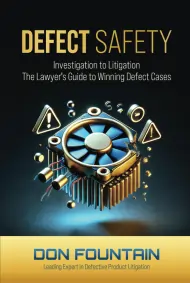The Week in Torts – Cases from the Week of September 11, 2020
When We say Last Pleading, We MEAN The Last Pleading
FLORIDA LAW WEEKLY
VOLUME 45, NUMBER 36
CASES FROM THE WEEK SEPTEMBER 11, 2020
COURT REVERSES FINAL JUDGMENT IN CASE WHERE CASE WAS SET FOR TRIAL, BUT FAILED TO STRICTLY COMPLY WITH RULE 1.440.
Chancey v. Young, 45 Fla. L Weekly D2086 (Fla. 5th DCA September 4, 2020):
Pursuant to Fla. R. Civ. P. 1.440(a), a case is at issue after the court disposes of any motions directed to the last pleading, or if no such motions are served, 20 days after service of the last pleading.
Once the case is at issue, a party may file and serve a notice that the case is ready to be set for trial. Then, if the trial court determines that the action is ready for trial, the trial court may in turn set a date for trial that is no less than 30 days from the service of the notice.
In this case, the last pleading was a reply to the defendant’s affirmative defenses filed on January 6, 2020. On January 22, 2020, the defendants filed a motion to strike plaintiffs’ reply. At some point, the plaintiffs noticed the case for trial.
Although the court did not rule on that motion to strike the plaintiffs’ reply until February 7, 2020, over the defendants’ objection, the trial court still conducted the trial on February 11, 2020, the date the court set after receiving plaintiffs’ notice.
Strict compliance with Rule 1.440 is mandatory, and the failure to follow it is reversible error. Because the matter was tried prematurely, and was not properly noticed for trial, the court reversed the final judgment.
TRIAL COURT ERRED IN ENTERING SUMMARY JUDGMENT BASED ON ITS CONCLUSION THAT THE PLAINTIFF WAS INJURED AS A RESULT OF AN OPEN AND OBVIOUS DANGER—EVEN WHEN A DANGEROUS CONDITION IS “OPEN AND OBVIOUS,” THE OCCUPIER OF THE PREMISES IS NOT EXCUSED FROM ITS DUTY TO PROTECT AND WARN INVITEES, IF IT SHOULD ANTICIPATE THAT THE CONDITION POSES AN UNREASONABLE RISK OF HARM.
Green v. Twistee Treat USA, 45 Fla. L Weekly D2101 (Fla. 2nd DCA September 4, 2020):
Plaintiff fell in a parking lot in the vicinity of a free-standing ice cream shop. After parking in the adjacent lot, the plaintiff and her children were walking towards the Twistee Treat when she caught her shoe in a depression in the pavement and fell. The defendants asserted that the depression was open and obvious, and that plaintiff could not establish a cause of action for negligence. The trial court agreed.
The court reversed. It explained that business owners owe invitees a duty to use reasonable care to maintain the premises in a reasonably safe condition, as well as a duty to give the invitee warning of concealed perils which are–or should have been– known to it, and which are unknown to the invitee and could not be discovered even if the invitee exercised due care.
While there is usually no obligation to protect invitees against dangers which are known to them or which are so open and obvious that they should be reasonably expected to discover them, in this case the plaintiff did not see the hole before she tripped, explaining that the depression was the same color and hue as the surrounding pavement. In this case, the hole was clearly manmade, and while there was no proof of the hole’s origin, the plaintiff posited that it was associated with a tent that in the past had been temporarily erected in the parking lot for the purposes of selling fireworks.
Based on this evidence, the jury could have concluded that the hole in the pavement was not so open and obvious and that the defendants could have reasonably expected that it would be discovered by an invitee such as the plaintiff.
Moreover, the open and obvious condition principle is certainly not a fixed rule, and all circumstances must be taken into account. Thus, even when a dangerous condition is open and obvious, the occupier of the premises is not excused from its duties to protect or warn invitees if it reasonably should anticipate that the condition poses an unreasonable risk of harm to the invitee, notwithstanding the obvious nature of the condition.
In this case, the record reflected that the Twistee Treat facility was an example of novel architecture (the building resembled an enormous ice cream cone) and the plaintiff recounted that she and her daughters were looking at the giant ice cream cone and commenting on it, as they made their way through the parking lot to the shop. The plaintiff was also guarding her children’s safety, keeping an eye out for vehicles as they crossed the parking lot.
A jury could conclude that defendants reasonably should have anticipated that an invitee negotiating the parking lot to visit the ice cream shop would be distracted by its striking appearance, and by the need to watch for approaching vehicles.
Because the proof for summary judgment must be conclusive and must “overcome all reasonable inferences which may be drawn in favor of the opposing party,” when the record reflects any genuine issue of material fact or the possibility of any issues, or if the record raises even the slightest doubt that an issue might exist, summary judgment is improper.



